1993 BUICK LESABRE washer fluid
[x] Cancel search: washer fluidPage 90 of 324
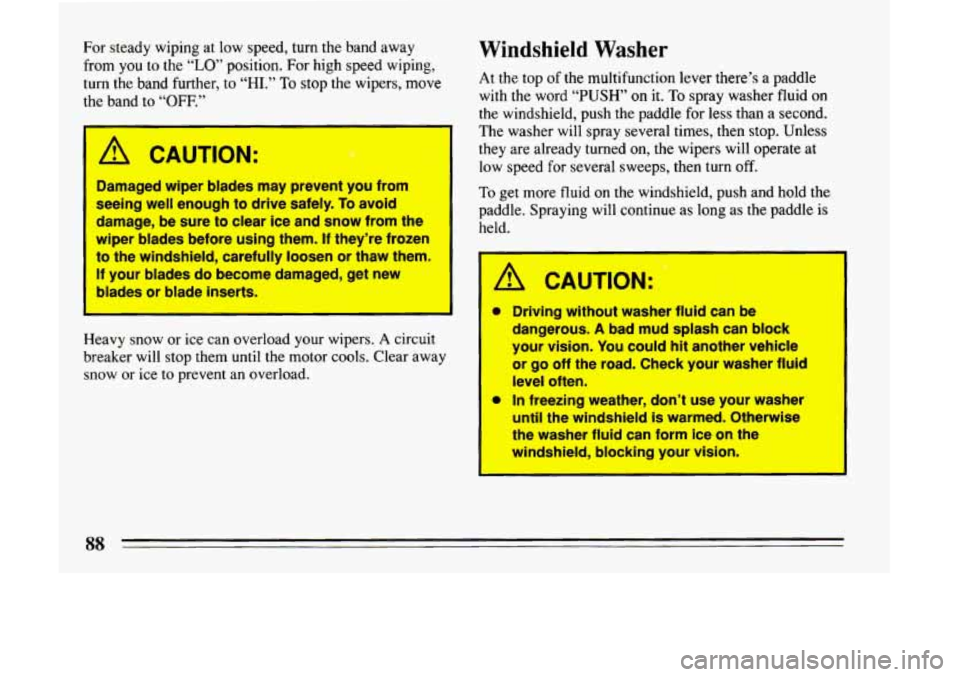
For steady wiping at low speed, turn the band away
from you to the
“LO” position. For high speed wiping,
turn
the band further, to “HI.” To stop the wipers, move
t’ band to “OFF.”
A CAUTION:
Damaged wiper blades may prevent you from
seeing well enough to drive safely.
To avoid
damage, be sure to clear ice and snow from the
wiper blades before using them. If they’re frozen
to the windshield, carefully loosen or thaw them.
If your blades do become damaged, get new
blades or blade inserts.
Heavy snow or ice can overload your wipers. A circuit
breaker will stop them until the motor cools. Clear away snow or ice to prevent an overload.
Windshield Washer
At the top of the multifunction lever there’s a paddle
with the word
“PUSH” on it. To spray washer fluid on
the windshield, push the paddle for less than a second.
The washer will spray several times, then stop. Unless
they are already turned on, the wipers will operate at
low speed for several sweeps, then turn
off.
To get more fluid on the windshield, push and hold the
paddle. Spraying will continue as long as the paddle is
held.
A CAUTION: ’
Driving without washer fluid can be
dangerous. A bad mud splash can block
your vision. You could hit another vehicle
or go off the road. Check your washer fluid
level often.
In freezing weather, don’t use your washer
until the windshield is warmed. Otherwise
the washer fluid can form ice on the
windshield, blocking
your vision.
I
88
Page 91 of 324

NOTICE:
When using concentrated washer fluid
iollow the manufacturer instructions for
~ Idding water.
I 0 Don’t mix water with ready to use washe
fluid
. Water can cause the solution to
freeze and damage your washer fluid tank
and other parts of
t
water doesn’t clean as well as washer
0 Fill your washer fluid tank only 3/4 full
when it’s very cold. This
allows for
expansion, which c
it is completely full.
0 Don’t use radiator a
windshield washer. It c
paint.
I
Cruise Control (Option)
With Cruise Control, you can maintain a speed of about
25 mph (40 km/h) or more without keeping your foot on
~ the accelerator. This can really help on long trips. Cruise
Control
does not work at speeds below about 25 mph
(40 km/h).
When you apply your brakes, the Cruise Control shuts
off.
Page 180 of 324
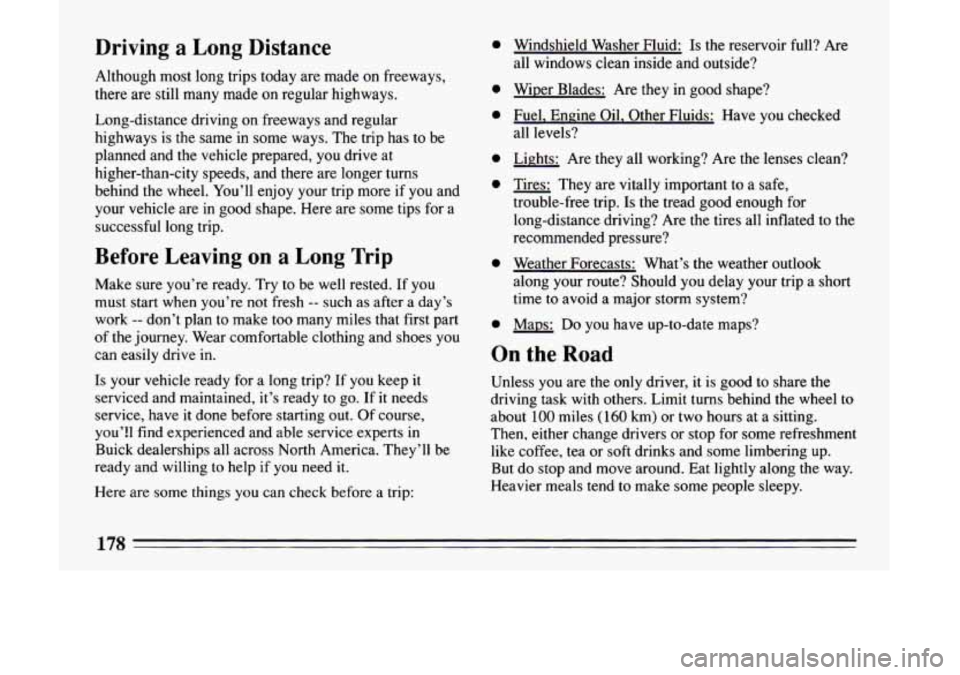
Driving a Long Distance
Although most long trips today are made on freeways,
there are still many made on regular highways. Long-distance driving on freeways and regular
highways is the same in some ways. The trip has to be
planned and the vehicle prepared, you drive at
higher-than-city speeds, and there are longer turns
behind the wheel. You’ll enjoy your trip more if you and
your vehicle are in good shape. Here are some tips for a
successful long trip.
Before Leaving on a Long Trip
Make sure you’re ready. Try to be well rested. If you
must start when you’re not fresh
-- such as after a day’s
work
-- don’t plan to make too many miles that first part
of the journey. Wear comfortable clothing and shoes you
can easily drive
in.
Is your vehicle ready for a long trip? If you keep it
serviced and maintained,
it’s ready to go. If it needs
service, have it done before starting out. Of course,
you’!! find experienced and able service experts in
Buick dealerships all across North America. They’ll be
ready and willing to help
if you need it.
Here are some things you can check before a trip:
0
e
e
0
e
0
0
Windshield Washer Fluid: Is the reservoir full? Are
all windows clean inside and outside?
Wiper Blades: Are they in good shape?
Fuel, Engine Oil. Other Fluids: Have
you checked
all levels?
Lights: Are they all working? Are the lenses clean?
- Tires: They are vitally important to a safe,
trouble-free trip.
Is the tread good enough for
long-distance driving? Are the tires all inflated to the
recommended pressure?
Weather Forecasts: What’s the weather outlook
along your route? Should you delay your trip
a short
time to avoid a major storm system?
Maps:
Do you have up-to-date maps?
On the Road
Unless you are the only driver, it is good to share the
driving task with others. Limit turns behind the wheel to
about
100 miles (160 km) or two hours at a sitting.
Then, either change drivers or stop for some refreshment
like coffee, tea
or soft drinks and some limbering up.
But do stop and move around. Eat lightly along the way.
Heavier meals tend to make some people sleepy.
Page 187 of 324
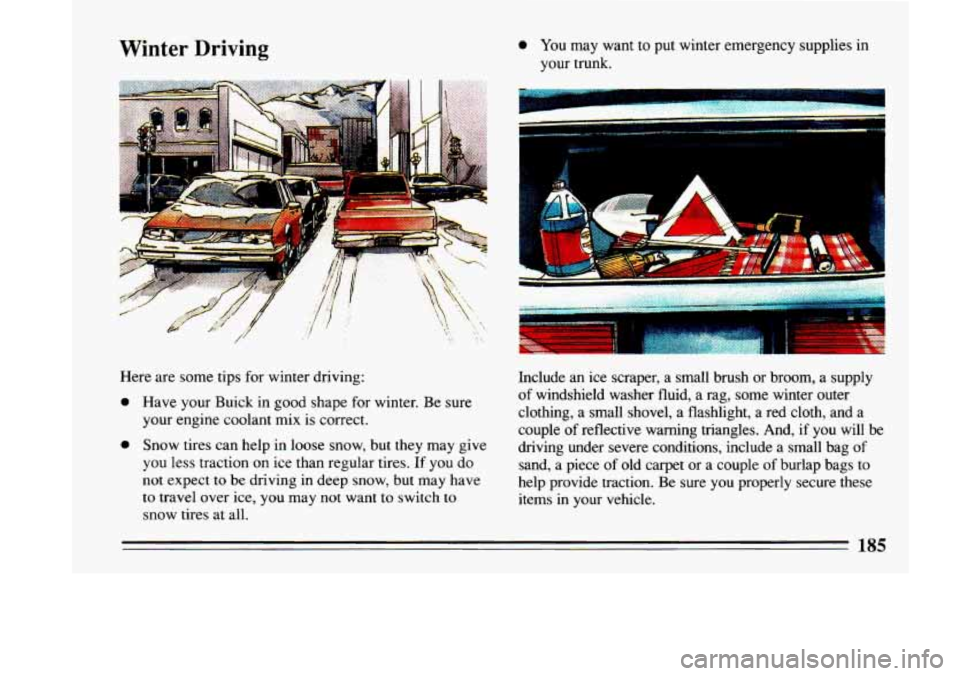
Winter Driving 0 You may want to put winter emergency supplies in
your trunk.
Here are some tips for winter driving:
0 Have your Buick in good shape for winter. Be sure
your engine coolant mix
is correct.
0 Snow tires can help in loose snow, but they may give
you less traction
on ice than regular tires. If you do
not expect
to be driving in deep snow, but may have
to travel over ice, you may not want to switch to
snow tires at all. Include an ice scraper,
a small brush
or broom, a supply
of windshield washer fluid, a rag, some winter outer
clothing, a small shovel, a flashlight, a red cloth, and a
couple
of reflective warning triangles. And, if you will be
driving under severe conditions, include a small bag
of
sand, a piece of old carpet or a couple of burlap bags to
help provide traction. Be sure you properly secure these
items in your vehicle.
185
Page 231 of 324

@ Part 6 Service & Appearance Lare
Here you will find information about the care of your Buick . This part begins with service and fuel information. and
then it shows how to check important fluid and lubricant level\
s
. There is also technical information about your
vehicle. and a section devoted to its appearance care .
Part 6 includes:
ServiceTips
......................................................................
Fuel ........................................................................\
.....
HoodRelease .....................................................................
Engineoil ....................................................................... \
AirFilter ........................................................................\
.
Automatic Transaxle Fluid ............................................................
Enginecoolant ....................................................................
Power Steering Fluid ...............................................................
Windshield Washer Fluid ............................................................
Brakes ........................................................................\
...
Battery ........................................................................\
..
BulbReplacement .................................................................
Tires ........................................................................\
.....
Appearancecare ..................................................................
Vehicle Identification Number (VIN) ..................................................
FusesandCircuitBreake ............................................................
Capacities and Specifications .........................................................
LoadingYourVehicle ...............................................................
230
231
234
236
240
241
243
246 247
248
249
250
253
255
262
269
270
275
229
Page 238 of 324

A CAUTION:
Things that burn can get on hot engine parts and
start a fire. These include liquids like gasoline,
oil, coolant, brake fluid, windshield washer and
other fluids, and plastic
or rubber. You or others
could
be burned. Be careful not to drop or spill
things that
will burn onto a hot engine.
I
Before closing the hood, be sure all the filler caps are on
properly.
Then just pull the hood down and close it firmly.
Engine Oil
It’s a good idea to check your engine oil every time you
get fuel. In order to get an accurate reading, the oil must
be warm and the vehicle
must be on level ground.
The engine oil dipstick is directly behind the engine fan.
Turn
off the engine and give the oil a few minutes to
drain back into the oil pan. If you don’t, the oil dipstick
might not show the actual level.
236
Page 249 of 324
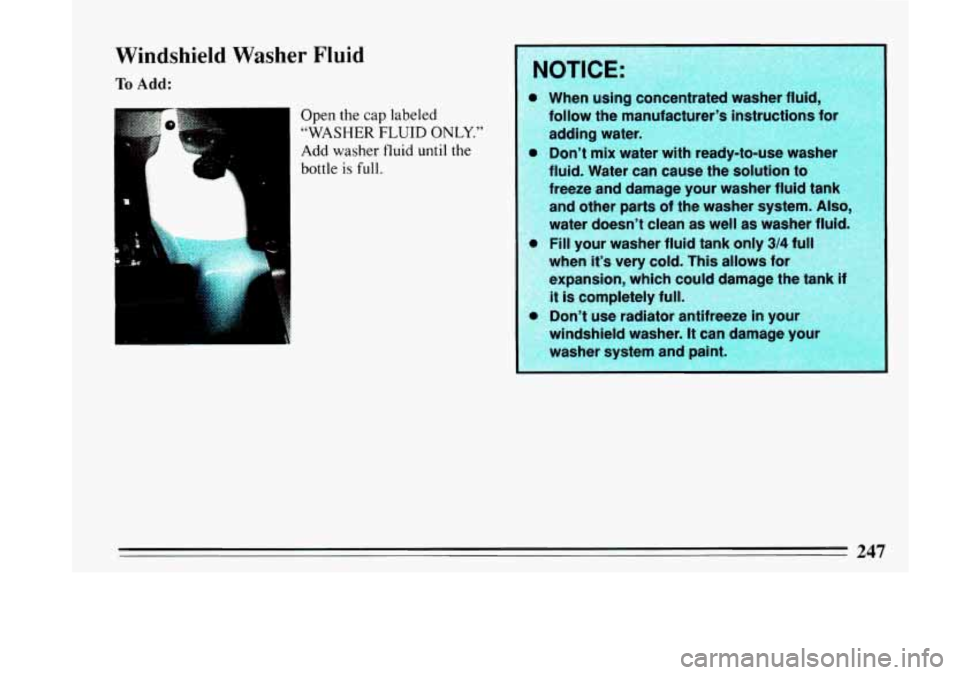
Windshield Washer Fluid
To Add:
Open the cap labeled
“WASHER FLUID ONLY.”
Add washer fluid until the
bottle
is full.
P
a
0
4OTICE
When using
follow the man
adding wate
Don’t mix wate
fluid. Water can cause the solution to
freeze and damage your washer fluid
and other parts of the washer system. Also
water doesn’t clean as well as washer
0 Fill your washer fluid tank only 3/4 fu
when it’s very cold. This allows for
expansion, which could damage the
it
is completely full.
0 Don’t use radiator antifreeze in you1
windshield washer. It can damage you
washer system and paint.
Page 290 of 324
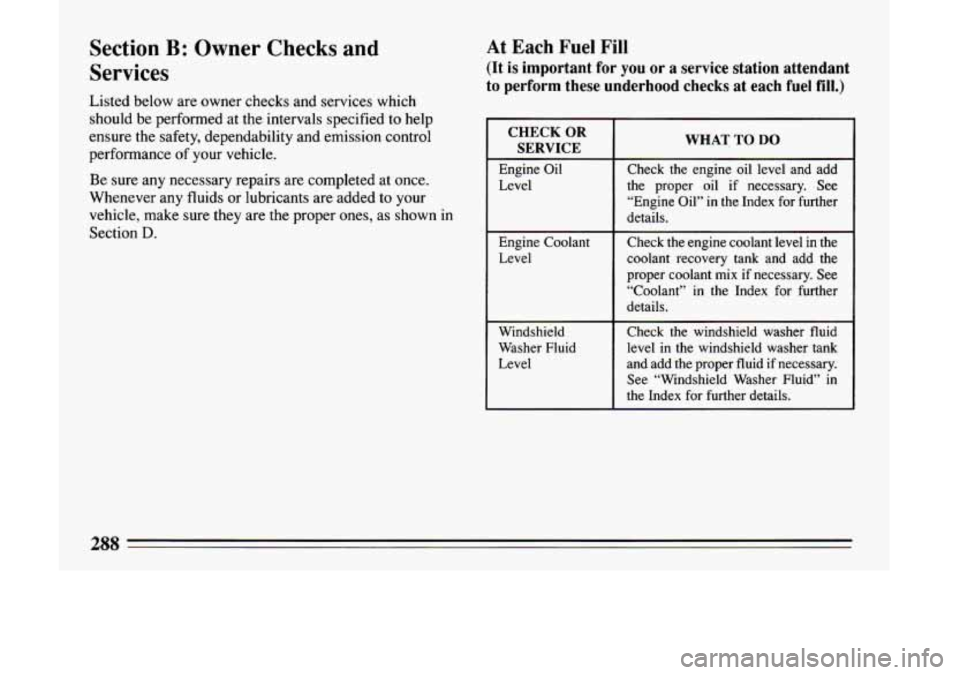
Section B: Owner Checks and
Services
Listed below are owner checks and services which
should be performed
at the intervals specified to help
ensure the safety, dependability and emission control
performance
of your vehicle.
Be sure any necessary repairs are completed
at once.
Whenever any fluids or lubricants are added to your
vehicle, make sure they are the proper ones, as shown
in
Section D.
At Each Fuel Fill
(It is important for you or a service station attendant
to perform these underhood checks at each fuel fill.)
CHECK OR
SERVICE
Engine Oil
Level
Engine Coolant
Level
Windshield
Washer Fluid
Level
WHAT TO DO
Check the engine oil level and add
the proper oil if necessary. See
“Engine Oil” in the Index for further
details.
Check the engine coolant level in the
coolant recovery tank and add the
proper coolant mix if necessary. See
“Coolant” in the Index for further
details.
Check the windshield washer fluid
level in the windshield washer tank
and add the proper fluid if necessary.
See “Windshield Washer Fluid” in
the Index for further details.
moo